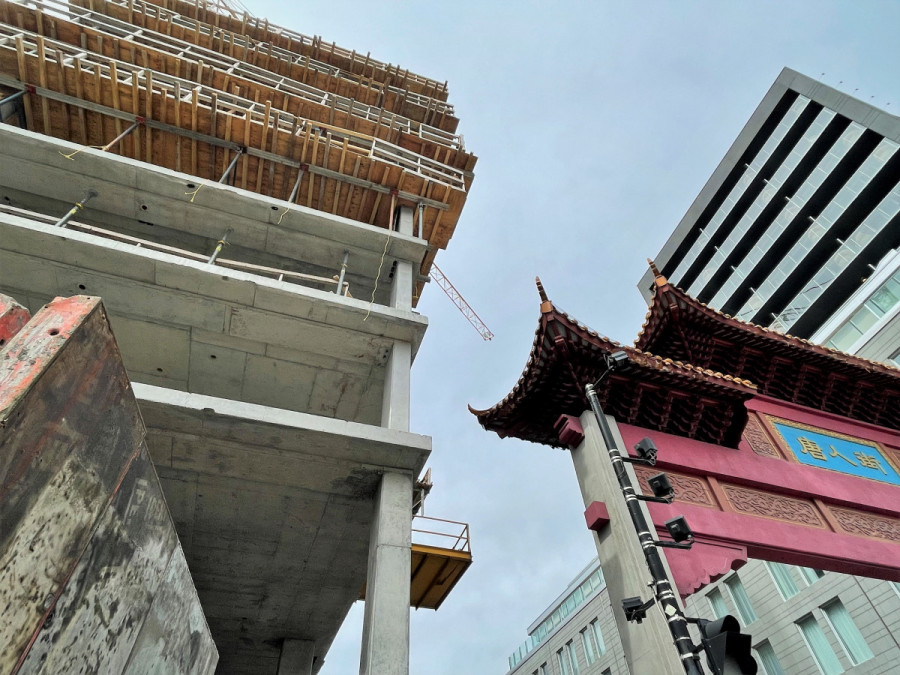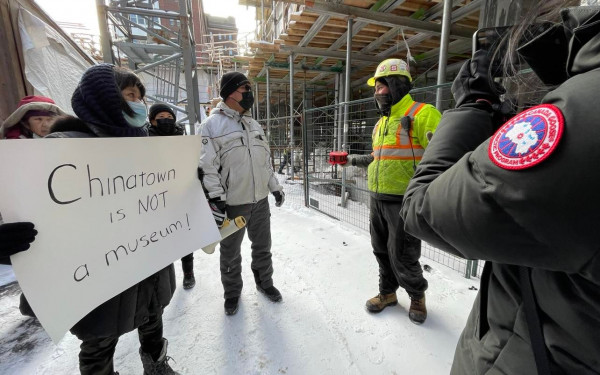The devastating consequences of proposed REM developments in Chinatown
‘Protecting the neighbourhood is more than just the buildings’
Urban planning experts, activists, and community members continue to oppose the development of the Réseau express métropolitain in Chinatown. Preservation of the neighbourhood is beyond infrastructure; it’s about prioritizing human welfare.
The $10 billion automated light rail project that originally began in April 2018 is set to include the construction of aerial structures and a train station in the Chinatown community space located on the corner of St. Laurent Blvd. and René-Lévesque Blvd.
The Caisse de dépôt et placement du Québec Infra’s plans were proposed to Chinatown’s community members, but were met with criticism and rejection from many, including the Chinatown Working Group.
The CWG began as a project from the Progressive Chinese of Quebec and is currently “motivated to protect, preserve, and promote the history and evergreen culture” of Montreal's Chinatown and its residents.
Their recent efforts included a collaboration with Heritage Montreal and the city council to curb real estate development affecting historical and residential areas along with the city’s five-year action plan.
Over the past year, the group expressed their concerns to the city through multiple press releases and conferences as designs for development were drawn. However, these designs were always made without community consultation, which largely ignored the potential implications brought forth.
These concerns include impacts on Chinatown’s visibility, accessibility, development, businesses, residents, and overall community space.
“They didn't consult anybody, and I don't understand [why] they just keep on imposing one design after another. Every single time, nobody is consulted, so nobody likes it,” said May Chiu, a member of both the PCQ and CWG.
“It’s just really badly designed and we’re really afraid that it would choke off all business to merchants in Chinatown.” — May Chiu
According to Chiu, the vacant lot at the intersection of St. Laurent and René-Lévesque boulevards that the CDPQ Infra has proposed for construction of the station is one of very few community spaces remaining in the area.
The privately owned lot has been rented by the city and has served residents over the past years as a place for artistic performances, food, a night market, and even hosted Chinatown’s first ever Pride event last year.
Christopher Vaccarella, Concordia Student Union councillor and sustainability committee member stated that local community should be the ones to decide how the land should be used and how it should serve Chinatown’s population.
“That is the biggest plot of land, and that should be the community's jurisdiction, what they want to see built there.”
With the financial repercussions of the pandemic over the past two years, merchants and local businesses are relying on the use of public spaces like the lot to attract and conduct business.
“We asked [CDPQ Infra], ‘Can you give us a design of how this REM would look from the north [to the] south?’ Of course, they didn't show [a design] because all you would see is a huge wall. You wouldn't see Chinatown at all,” said Chiu. “It's just really badly designed and we're really afraid that it would choke off all business to merchants in Chinatown.”
Community members fear the aerial development would hide and box-in the historical heritage site officially titled the “site patrimonial du Noyau-Institutionnel-du-Quartier-Chinois.”
“If it was developed in its current form, not only would it be a physical barrier, but it would actually close off one of the streets into Chinatown. So Jeanne-Mance St. would be completely closed off, and Jeanne-Mance St. all the way to St. Laurent Blvd. would basically be almost a physical wall,” said Donny Seto, CWG member and Concordia urban planning lecturer.
“I witnessed the disappearance of Chinatown in Quebec City. I am really hopeful that this doesn’t happen in Montreal as well. To experience that loss again—that would be soul-crushing.” — Donny Seto
“Protecting the neighbourhood is more than just the buildings,” Vaccarella added. “Of course, developing in the city’s downtown [area] is a good thing, but not at the expense of a cultural neighbourhood in the middle of it.”
Like many others, Seto advocates for an underground REM instead, noting that if above-ground aerial construction plans were to follow through, the disruption and roadworks would last for two to three years, “[depriving] Chinatown economically.”
During his childhood, Seto lived in Quebec City’s Chinatown, where he listened to his parents speak Cantonese openly and watched people celebrate cultural events, such as Lunar New Year.
“It went from this hustling and bustling community to nothing, overnight. I witnessed the disappearance of Chinatown in Quebec City,” said Seto. “I am really hopeful that this doesn't happen in Montreal as well. To experience that loss again, that would be soul-crushing.”
Seto fears the area would be turned into a heavy construction zone and as a result would have long-term repercussions on the neighbourhood.
Apart from the added noise and accessibility issues that would arise, construction of the REM station could potentially promote further condo development and gentrification that would continue to hurt Chinatown.
Seto stated many recent immigrants and senior residents live in the area to have a closer connection with their native languages and cultures. “This population is already on a fixed income, so any changes in housing prices will drive them out,” Seto said.
The CWG is calling for building height and density reviews as development will raise costs of living and continue to impact an already vulnerable demographic.
“Chinatown doesn't need more density. It just needs better access to the population that is around it to reinforce it economically,” Seto added. “There needs to be some type of reflection in terms of how to promote accessibility to Chinatown and this project, instead of promoting it, will actually do the opposite.”
According to Chiu, CDPQ Infra responded positively to a recent request for community consultation, but a date has yet to be confirmed.
The Montreal-wide REM project is set to be completed by the end of 2024.
With files from Alexa Toguri-Laurin.
This article originally appeared in The Sidewalk Issue, published April 5, 2022.


_600_832_s.png)




